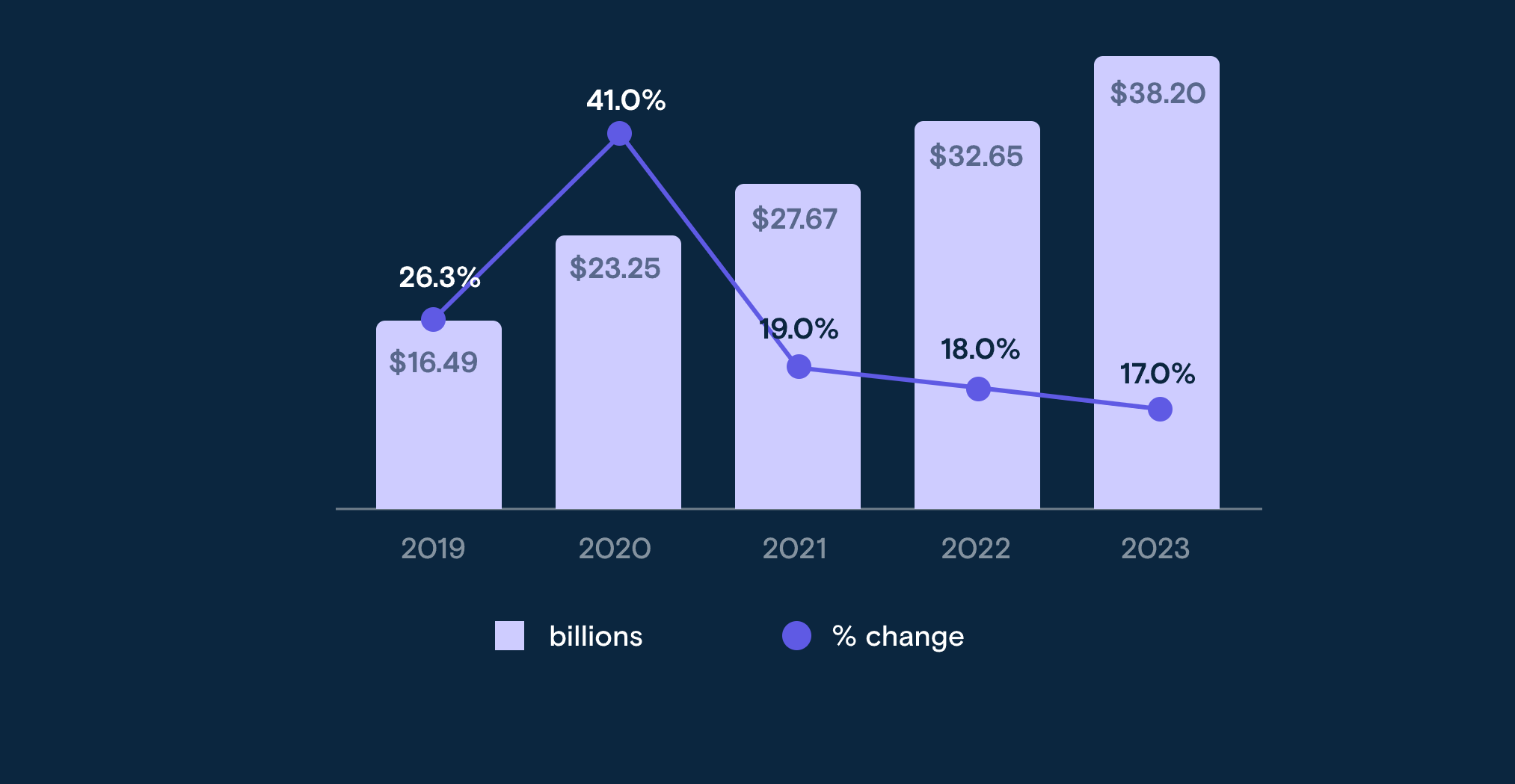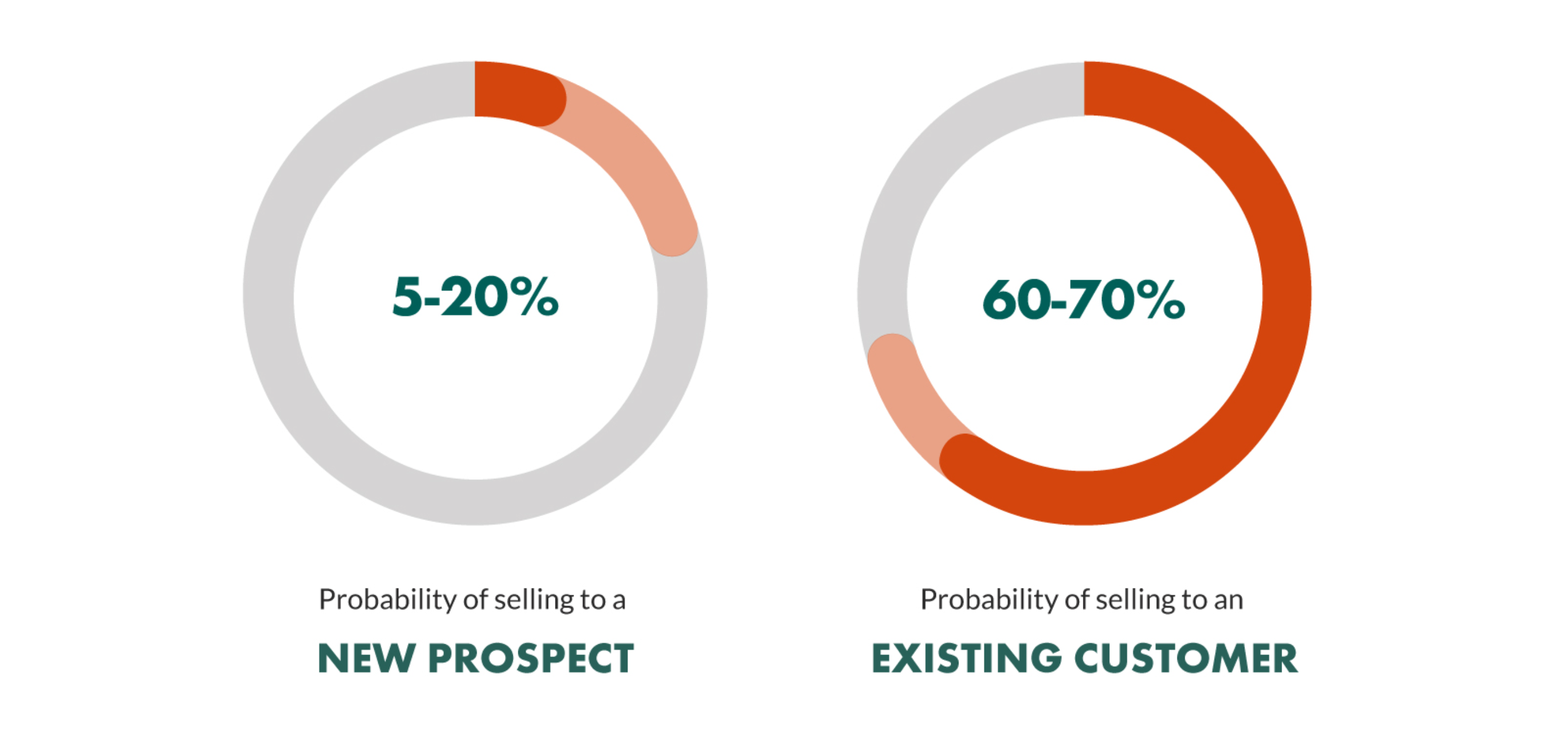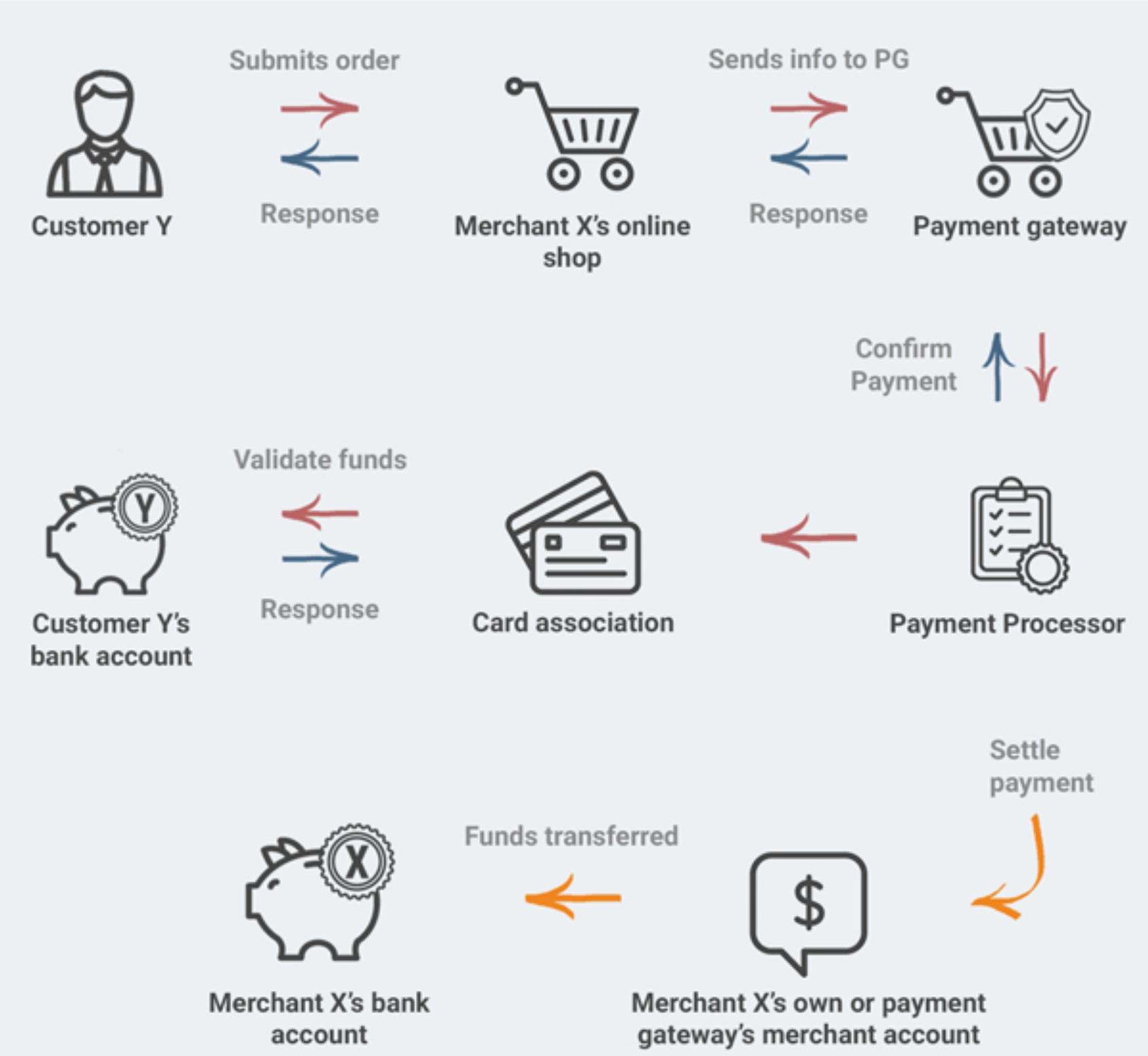As any eCommerce or subscription business knows, customer retention is the key to business longevity and continuity.
Discover and read more about how you can retain a competitive business with our guide today.

Discover and read more about how you can retain a competitive business with our guide today.
eCommerce subscriptions for goods and services are skyrocketing, with U.S. sales growing more than 40% year-over-year from 2019 to 2020. While the growth rate may slow modestly in the years ahead, by 2023 the e-commerce subscription market is forecast to represent close to $40 billion.

Image source: eMarketer
When a payment fails, it not only puts a company's revenue at risk, but can lead to customer churn and destroy customer relationships.
While some degree of customer churn is unavoidable, a customer lifetime value is the basis of success for subscription businesses, and in particular SaaS companies. So the focus on reducing involuntary churn and voluntary churn is paramount.
Overall churn is detrimental to a business, but in this blog we'll focus on why involuntary churn occurs, how involuntary churn affects companies and ways to increase the rate of engaged customers.
What exactly is customer churn rate?
Customer churn rate, also known as the rate of attrition, is defined as the rate at which customers stop doing business with a company.

Image source: Onix systems
It's most commonly expressed as the percentage of service subscribers who discontinue their subscriptions within a given period of time. Customers cancel their subscription because of failed payments, cash flow issues, poor customer experience and other issues.
Failed payments are inevitable in payment processing, and can happen for a number of reasons, but a high customer churn rate will eventually affect a subscription company's ability to make a profit, and will severely affect its ROI.
Read more about managing and preventing failed payments here
Voluntary churn vs involuntary churn
While there's no easy solution to reducing churn rate, there are standard measures you can take to help keep it low. Basically, churn comes down to your product, and your industry, and relates to how your product competes with others in the same space.
Voluntary churn is when a customer actively decides to initiate the exit . This could be a subscription cancellation through dissatisfaction with the product, no further need for the product, or not receiving the value they thought they would. It's far more difficult to reduce voluntary churn, as a subscription business needs to deploy more labor-intensive strategies that can take time and resources, with little to no guarantee of customer retention.
Involuntary churn means customer churn is due to payment failure due to things like outdated information, for example an incorrect card expiration date, wrong billing address, insufficient funds, or some other reason not related to the business. Unlike voluntary churn, a subscription business can proactively manage involuntary churn.
A close look at involuntary churn
Subscription commerce carries a high churn risk because the payment information captured when a customer first logs in is held over the entire duration of the subscription. This means that with every consecutive renewal, the payment has the potential to fail and become 'passive churn' if customer details aren't kept up to date.
Preventable involuntary churn
On average, renewals account for 62% of subscription revenue. Subscription businesses need to take a holistic approach to tackling involuntary churn, to meet both payment and customer life-cycle needs - but few use a full service provider.
Involuntary churn can affect satisfied customers whose payment method fails because of their billing system. But with attention to detail and some dedicated marketing measures, companies can reduce involuntary churn. A single, integrated solution to manage customer retention rates can improve subscription management, payment and order management, and customer care.
Payment processing issues:
Soft declines. These are temporary authorization failures which may be successful upon re-trial of payment. Reasons for soft declines include:
- Insufficient funds
- Card activity limit exceeded
- Processing failures – timeouts
- Expired cards
Hard declines. Permanent authorization failures that can't be recovered and should not be retried. It's estimated that 10 to 20% of declines are hard declines. Reasons for hard declines include:
- Stolen or lost card
- Invalid credit card data
- Account closed
Payment card data can change for a variety of reasons. Credit cards expire, customers might receive a new card as the result of an upgrade due to the introduction of new technologies (EMC, chip cards, etc.), or because they lost their card.
Your loyal customer has been using your product or service for so long that they've reached their card's expiration date, or not updated their new card number, resulting in losing access to their paid account.
The problem with involuntary churn is that your customer probably didn't realize that their subscription was at risk of being cancelled.
Reducing both voluntary and involuntary churn should be a priority for subscription businesses. But according to a Forrester study, involuntary churn isn't a marginal problem, and accounts for a substantial 34% of the overall churn rate.

Image source: Bare Metrics
Ways to prevent payment failures
One way to prevent failed transactions, reduce involuntary churn and to ensure your customers’ payment card data is up-to-date would be to find a payment processor whose merchant account is equipped with auto-updates.
Automation capabilities could include AI-based algorithms that can automatically update payment card information or enable companies to use an alternative customer card to process failed transactions.
If these algorithms are properly tailored and optimized, a subscription business can recover a significant amount of failed transactions and reduce involuntary churn rates.
Another means of reducing involuntary churn for subscription companies would be to send customers automatic notifications before their credit cards expire. This would involve setting up notifications through a payment processor to let customers know at least two weeks in advance of their credit (or debit) card's expiration date.
As a backup, and to maintain a successful business, subscription companies should have measures in place to send customers a notification asking them to provide an alternative means of payment if payments fail.
Click here to download a comprehensive guide to managing your changing payments business
Customer acquisition cost
Every business needs to spend money to attract new customers, and this is known as Customer Acquisition Cost (CAC). It's a key business metric commonly used in conjunction with the customer lifetime value metric to measure value generated by a new customer.
As subscriptions businesses are well aware, it's much cheaper to retain existing customers than to acquire new ones. If involuntary churn occurs before the business recoups the money spent on acquisition, its CAC increases.

Image source: Super Office
Primary reasons for involuntary churn
A survey of 204 subscription businesses conducted by Forrester revealed some of the key reasons for failed recurring payments, resulting in involuntary churn.

Customer relationships are at the core of all successful SaaS companies, and any measures taken to prevent payment failures and increase customer lifetime value will protect a company's revenue. Let's have a more detailed look at some of the tactics that subscription businesses can deploy to help reduce involuntary churn rates through payment failures.
When payment is due
Pre-dunning emails. Send out an email to your customer reminding them that their card details are about to expire.
In-app notifications. A subtle notification bubble inside your app or website–reminding your customers to update their payment method.
Card or Account updater. Employ payment gateways like Stripe or Braintree partner with credit card issuers like Visa and Mastercard to update the cards in your system without customer intervention, automatically.
Card or Account updater information on your website. If you’re using the card/account updater information, use a webhook to display updated card details on your website or dashboard. You don’t need your customers updating when an update isn’t required.
Alternative payment gateways or processor. Have a backup payment gateway or payment processor. If the primary gateway/processor is down, a secondary option should help ensure smooth functioning.
Flag a payment as recurring. Tag a payment as 'recurring' with your payment gateway so that multiple charges on the same payment method won't be tagged as suspicious, and hold up the payment process.
Retrying a payment method
Either ‘soft or hard declines’ cause payment failures. In many cases, a retry will usually fix payments that fail due to these declines.
Segment your retry cycle for a soft decline. Soft card declines are declines that result from a temporary problem with a gateway, payment processor, or network. It would be best to retry this type immediately.
Segment your retry cycle for a hard decline. Hard card declines an payment fails can result from insufficient funds, stolen cards, etc. Retry a hard decline over two weeks or a month, depending on the ticket size.
Retry at particular times. Pick up data/metrics from your payment gateway to find out what time might be best for a retry during the day. Ayden’s found that payments during nighttime hours have a 2% lower success rate.
As mentioned, subscriber retention is vital to the success of a business that bases its revenue on subscription services, so measuring and reducing churn is a crucial aspect of successfully scaling an organization.
When customers actively decide to cancel a subscription, businesses need to look at different strategies to either win them back, or re-evaluate their marketing and customer retention tactics. While voluntary churn is more difficult to address, data and analytics can help reveal the reasons why it happens in the first place.
Securing customer satisfaction
Reducing voluntary churn means actively engaging your customers with your product through personal contact. Give them reasons to keep coming back by showing them the day-to-day value of using your products, by making your products, services, offers, etc. a part of their daily workflow.
While both voluntary churn and involuntary churn are serious issues for subscription businesses, reducing involuntary churn, requires businesses to deploy a separate set of strategies to keep their recurring payments flowing, and prevent lost revenue.
These strategies, not unlike voluntary churn, include collecting and analyzing payment data to determine why a payment failed.
The importance of real time transaction monitoring
There's probably no area as complex in business as the payment processing industry. With each and every payment, there's a lot going on.

Image source: ChargeBee
Without stringent monitoring, payment processors, merchants, card issuers and banks are open to frequent payment failure.
The world of real-time payments offer a faster, more consistent means of payment, but payment providers and payment processing organizations need to ensure that their real-time payments systems are optimized for peak performance.
With IR Transact, you can track every detail of your payment system workflows, and monitor and manage real-time payments to ensure overall payment health, and deliver results that drive optimal business outcomes.
You can’t optimize something if you can’t measure it — and you won’t be able to measure it, if you can’t see it. This is where transaction monitoring comes in.
According to Forrester, insufficient funds are responsible for 53% of failure of recurring payments. If you have access to data insights gathered through monitoring, you’ll be able to proactively counteract this issue.
Without transaction data and analytics to get clear visibility into the payments environment, a business wouldn't be able to identify transaction performance issues, or detect fraud, failed payments and other anomalies.
Find out how using payments data can give you unparalleled insights and simplify complexity in your payments systems

Discover and read more about how you can retain a competitive business with our guide today.

Discover and read more about how you can retain a competitive business with our guide today.




